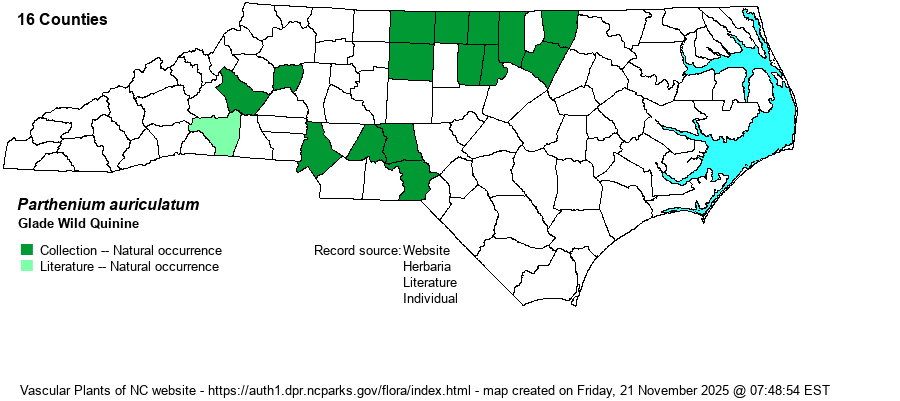| Section 6 » Order Asterales » Family Asteraceae |
Show/Hide Synonym
| taxonName | relationship | relatedTaxonName | relatedTaxonRefText | relComments |
|---|
|
|
|
|
|
|
| Parthenium auriculatum | = | Parthenium integrifolium var. auriculatum | Radford, Ahles, and Bell (1968) | | | Parthenium auriculatum | = | Parthenium integrifolium var. auriculatum | Strother in FNA (2006c). | | | Parthenium auriculatum | = | Parthenium hispidum var. auriculatum | Fernald (1950) | | | Parthenium auriculatum | = | Parthenium hispidum var. auriculatum | Flora of West Virginia | | | Parthenium auriculatum | < | Parthenium integrifolium | Flora of North America (1993b, 1997, 2000, 2002a, 2002b, 2003a, 2004b, 2005, 2006a, 2006b, 2006c, 2007a, 2009, 2010) | | | Parthenium auriculatum | < | Parthenium integrifolium | Small (1933, 1938) | | | Parthenium auriculatum | < | Parthenium hispidum | Wofford (1989) | | | Source: Weakley's Flora |
|
| Author | Britton | |
| Distribution | Piedmont and foothills, but not known from the Mountains. The specimens from Burke County are from south and southeast of Morganton, near or on diabase dikes. The Alexander County record is from an oak-hickory forest just west of Vashti. The Rutherford County report has no voucher specimen. A Macon County specimen at DUKE is P. integrifolium.
The Piedmont and adjacent lower Mountains, from northern VA and WV south to eastern AL. | |
| Abundance | Uncommon and somewhat local in the northern and northeastern Piedmont, but rare over the remainder of the Piedmont. Though this is a Significantly Rare species, there are enough records that it perhaps should be moved to the Watch List. | |
| Habitat | Dry to xeric margins of oak-hickory woodlands, openings in such woodlands, glades, barrens, and powerlines -- always in circumneutral soil. Occurs mostly over diabase rock. |
| Phenology | Flowering and fruiting mid May-August. | |
| Identification | Plants grow 1.5-3 feet tall from a thickened rootstock. Basal leaves are much the largest, ovate, long-stalked, but stem leaves are sessile and their bases usually clasp the stem (i.e, auriculate). Stems are hairy with coarse hairs 1-3 mm long and leaves are very rough-textured (scabrous surfaces). Common Wild Quinine (P. integrifolium) can grow with it but has stem leaves with short stalks, or may be sessile, but do not clasp the stem; stem hairs are less than 1 mm long; and leaf surfaces are less harsh to the touch. Despite these two species often growing nearly side-by-side in some areas, there seems to be no indication of hybridization. At a glance, plants of this species have a glaucous (pale green) look to the leaves, whereas P. integrifolium leaves are a standard rather rich or dark green. | |
| Taxonomic Comments | In some treatments this is a variety of Common Wild Quinine; RAB (1968) named it as P. integrifolium var. auriculatum. Most current references do treat it as a good species.
| |
| Other Common Name(s) | None | |
| State Rank | S3 | |
| Global Rank | G3G4 | |
| State Status | SR-T | |
| US Status | | |
| USACE-agcp | | |
| USACE-emp | | |

